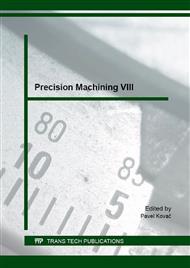[1]
J. Yu, Y. Namba, Atomic surface roughness, Applied Physics Letters 73 (1998) 3607-3609.
DOI: 10.1063/1.122839
Google Scholar
[2]
Y. Namba, J. Yu, J.M. Bennett and K., Yamashita, Modelling and measurements of atomic surface roughness, Applied Optics, 39 (16) (2000) 2705-2718.
DOI: 10.1364/ao.39.002705
Google Scholar
[3]
Y.V. Shusterman , N.L. Yakovlev and L.J. Schowalter, Ultra-thin epitaxial Al and Cu films on CaF2/Si(111), Applied Surface Science, 175 (2001) 27-32.
DOI: 10.1016/s0169-4332(01)00033-2
Google Scholar
[4]
Z. –H. Hong, S. -F. Hwang and T. -H. Fang, Atomic-level stress calculation and surface roughness of film deposition process using molecular dynamics simulation, Computational Materials Science 48 (3) (2010) 520-528.
DOI: 10.1016/j.commatsci.2010.02.018
Google Scholar
[5]
S. -F. Hwang, Y. -H. Li and Z. -H. Hong, Molecular dynamic simulation for Cu cluster deposition on Si substrate, Computational Materials Science 56 (2012) 85-94.
DOI: 10.1016/j.commatsci.2012.01.010
Google Scholar
[6]
I. Misumi, K. Naoi, K. Sugawara and S. Gonda, Profile surface roughness measurement using metrological atomic force microscope and uncertainty evaluation, Measurement 73 (2015) 295-303.
DOI: 10.1016/j.measurement.2015.05.026
Google Scholar
[7]
M. Cai, X. Li and M. Rahman, Molecular dynamics modelling and simulation of nanoscale ductile cutting of silicon, International Journal of Computer Applications in Technology 28 (1) (2007) 2-8.
DOI: 10.1504/ijcat.2007.012325
Google Scholar
[8]
Y. Guo, Y, Liang, M. Chen, Q. Bai and L. Lu, Molecular dynamics simulations of thermal effects in nanometric cutting process, Science China Technological Sciences 53 (3) (2010) 870-874.
DOI: 10.1007/s11431-009-0243-9
Google Scholar
[9]
W.C.D. Cheong, L. Zhang and H. Tanaka, Some essentials of simulating nano-surface processes using the molecular dynamics method, Key Engineering Materials 196 (2001) 31-42.
DOI: 10.4028/www.scientific.net/kem.196.31
Google Scholar
[10]
Z. -C. Lin, Z. -D. Chen and J. -C. Huang, Establishment of a cutting force model and study of the stress-strain distribution in nano-scale copper material orthogonal cutting, International Journal of Advanced Manufacturing Technology 33 (5-6) (2007).
DOI: 10.1007/s00170-006-0480-z
Google Scholar
[11]
S.J. Plimpton, Fast parallel algorithms for short-range molecular dynamics, Journal Comp. Phys. 117 (1995) 1- 19 and www. lammps. sandia. gov.
Google Scholar
[12]
Visual Molecular Dynamics (VMD), http: /www. ks. uiuc. edu/Research/vmd.
Google Scholar
[13]
A.O. Oluwajobi, PhD Thesis, Nanomachining technology development, University of Huddersfield (2012).
Google Scholar
[14]
A.O. Oluwajobi and X. Chen, The effect of depth of cut on the molecular dynamics (MD) simulation of multi-pass nanometric machining, Proceedings of the 17th International Conference on Automation & Computing, (2011) 40-45.
DOI: 10.4028/www.scientific.net/kem.496.241
Google Scholar
[15]
A. Stukowski, Visualization and analysis of atomic simulation data with OVITO – The open visualization tool, Modelling Simul. Mat. Scien. Eng. 18 (2010) 015012-015018.
DOI: 10.1088/0965-0393/18/1/015012
Google Scholar
[16]
L. Blunt and X. Jiang, Advanced Techniques for Assessment Surface Topography: Development of a Basis for 3D Surface Texture Standards Surfstand, London, Kogan Page Science, (2003).
Google Scholar


